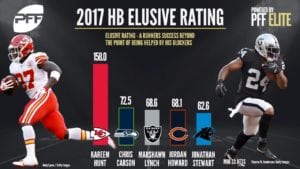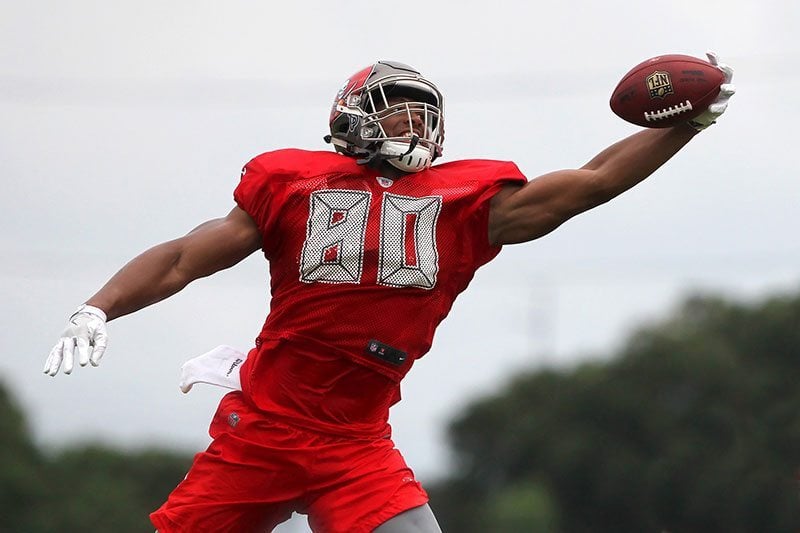FAB 2. Bucs Stuck In Rush Hour In The NFL
In the age of the franchise quarterback is the running game even important anymore?
You better believe it is, and here is why.
Despite an influx of young, talented quarterbacks entering the league over the last couple of years – and perhaps because of it – the running game is seeing a revival of sorts in the NFL. Yet don’t look for the league to revert back to its glory days of the running game where three yards and a cloud of dust was a big part of the game plan.
The passing game is alive and well in the NFL with plenty of prolific passers like New Orleans’ Drew Brees, New England’s Tom Brady and San Diego’s Philip Rivers still slinging the ball with great regularity and recording 4,000-yard seasons nearly every year. The last two NFL MVPs have been quarterbacks that have guided their teams to the Super Bowl – Carolina’s Cam Newton in 2015 and Atlanta’s Matt Ryan last year – they were beaten by older, more experienced and more storied quarterbacks in Denver’s Peyton Manning and Brady, respectively.

Cowboys QB Dak Prescott – Photo by: Getty Images
Manning retired after the 2015 season at age 40. Brady just turned 40. Brees will be 39 in January. Arizona’s Carson Palmer is 38. New York Giants quarterback Eli Manning, who is Tampa Bay’s next opponent this Sunday at Raymond James Stadium, is 36. Rivers turns 36 in December and Pittsburgh’s Ben Roethlisberger will be 36 next year. The demand for young star QBs over the last couple of years has never been higher.
The recent crop of promising quarterbacks age 26 or younger include Oakland’s Derek Carr and Jacksonville’s Blake Bortles from the 2014 draft, Tampa Bay’s Jameis Winston, Tennessee’s Marcus Mariota and Denver’s Trevor Siemian from the 2015 draft, the Los Angeles Rams’ Jared Goff, Philadelphia’s Carson Wentz and Dallas’ Dak Prescott from the 2016 draft and Houston’s Deshaun Watson and Cleveland’s Deshone Kizer.
The jury is still out on other recent highly drafted quarterbacks such as New England’s Jimmy Garoppolo (2014), Denver’s Paxton Lynch (2016), Indianapolis’ Jacoby Brissett (2016), Chicago’s Mitch Trubisky (2017) and Kansas City’s Patrick Mahomes (2017) due to a lack of playing time.
What does this have to do with the importance of the running game in the modern day NFL? Nothing helps develop an inexperienced quarterback like a strong running game that can provide balance to an offense and take pressure off young passers. Outside of the victory formation, the easiest thing for a quarterback to do in the NFL is turn around and hand the ball off.
“When you can run the ball it does help,” said Manning, who had a Pro Bowl running back Tiki Barber in his first two seasons (2005-06) in New York. “When things are tough you can have a guy who can bail you out. You can just hand it off and it gets you in good third down distances. You aren’t stuck in third-and-long and holding the ball a long time. It should set up play action where you can hand the ball off and then you can set up play action. You should get [a] single high [safety look] and some good reads. You can check the ball down and find completions. You don’t have to go out and throw for 350 yards and make every perfect read. You can take your shots down the field and know that you have that running game to fall back on.”

Giants QB Eli Manning and former RB Tiki Barber – Photo by: Getty Images
After a temporary trend that saw a good deal of NFL teams turn away from a franchise back approach to a running back-by-committee system made up of situational backs, the franchise back and the importance of a 1,000-yard rusher is being reinstituted. That’s why we’ve recently seen NFL teams buck the supposed conventional wisdom of “running backs are a dime a dozen” and “you can find running backs anywhere” and spend premium draft picks on top-flight rushers over the last couple of years.
Over the last two seasons in the NFL, the ground game seems to be making a welcomed resurgence thanks to the arrival of several talented young running backs. Last year, the top two leading rushers in the league were Dallas’ Ezekiel Elliott (1,631) and Chicago’s Jordan Howard (1,313), both of whom were rookies. Elliott was the fourth overall pick in 2016, while Howard was a fourth-round pick.
A glance at the current top 10 rushers in the NFL through Week 3 shows that seven of the 10 are age 25 and younger.
Top 10 NFL Rushers In 2017
1. Kansas City RB Kareem Hunt (22) – 47 carries, 401 yards, 4 TDs
2. Minnesota RB Dalvin Cook (22) – 61 carries, 288 yards, 1 TD
3. San Francisco RB Carlos Hyde (27) – 49 carries, 253 yards, 2 TDs
4. L.A. Rams RB Todd Gurley (23) – 63 carries, 241 yards, 4 TDs
5. Denver RB C.J. Anderson (26) – 53 carries, 235 yards, 1 TD
6. Atlanta RB Devonta Freeman (25) – 52 carries, 227 yards, 4 TDs
7. Jacksonville RB Leonard Fournette (22) – 57 carries, 199 yards, 3 TDs
8. Chicago RB Jordan Howard (23) – 45 carries, 197 yards, 3 TDs
9. Dallas RB Ezekiel Elliott (22) – 55 carries, 192 yards, 1 TD
10. Tennessee RB DeMarco Murray (29) – 35 carries, 184 yards, 1 TD
Now more than ever, NFL teams are making sure young quarterbacks are paired with young, talented running backs to make sure the game does not rest on the shoulders of inexperienced passers each week. Yet the Bucs haven’t done this for Winston. I’ll have more on that in Fab 3.

Cowboys RB Ezekiel Elliott – Photo by: Getty Images
Last year, Tennessee signed Murray, a high-priced free agent, and still spent a second-round draft pick on Heisman Trophy winner Derrick Henry to give Mariota a strong ground game to rely on. Tennessee has begun 2017 with a 2-1 record.
Dallas made Elliott the fourth overall pick in 2016 and drafted Prescott in the fourth round. That dynamic duo led the Cowboys to a 13-3 record, including a 26-20 win over the Buccaneers. The Cowboys are 2-1 through the first three games of the year.
With Todd Gurley, the 10th overall pick in the 2015 draft, already in fold, the Rams made Goff the first overall selection in 2016.
In an effort to revive the struggling career of Bortles, the third overall pick in 2014, Jacksonville spent the third overall pick this year on Fournette. Jacksonville is off to a 2-1 start and Bortles has six touchdowns and just two interceptions thus far.
A year after spending a fourth-round pick on Howard, Chicago came right back in the fourth round to draft Tarik Cohen – likely due to the fact that the Bears drafted Trubisky with the second overall pick. Howard and Cohen combined for 216 yards rushing and two touchdowns, including Howard’s 19-yarder in overtime, to beat Pittsburgh last week and record its first victory of the season.
This year, after using its first-round pick on Mahomes, who is the heir apparent to Alex Smith, Kansas City drafted Hunt, the rookie sensation who is leading the NFL in rushing and all-purpose yards, in the third round. According to Pro Football Focus, Hunt is not only the highest graded running back through Week 3 with a 90.5 rating, he is also the most elusive back in the league with a 158 rating. Seattle rookie Chris Carson is a distant second with a 72.5 rating.
 Houston did the same thing after drafting Watson in the first round by using a third-round pick and staying in state to select Texas running back D’Onta Foreman.
Houston did the same thing after drafting Watson in the first round by using a third-round pick and staying in state to select Texas running back D’Onta Foreman.
Even pass-happy New Orleans jumped on the running back bandwagon. Despite seeing 27-year old Mark Ingram record his first 1,000-yard season in 2016, the Saints signed future Hall of Famer Adrian Peterson and then used a third-round pick to draft Alvin Kamara.
Yet despite the insurgence of all of these young, talented rushers, the passing game isn’t going away. Rule changes over the last decade have further protected quarterbacks and receivers from injury and favored the passing game.
The last seven years have seen the highest amount of passing yards per game in NFL history:
1. 2015 – 243.8
2. 2016 – 241.5
3. 2014 – 236.8
4. 2013 – 235.6
5. 2012 – 231.3
6. 2011 – 229.7
7. 2017 – 226.8
The last five years have also seen the highest completion percentage per year in NFL history:
2017 – 64.2
2015 – 63.0
2016 – 63.0
2014 – 62.6
2013 – 61.2
Back in the 1990s and early 2000s, the notion was that a team had to have a 1,000-yard running back to get to the playoffs and win. Over the last 20 years, the league has had at least 15 1,000-yard rushers in 15 of those seasons. In 1998, the NFL set a record with 20 1,000-yard running backs. Two years later in 2000, the league broke that record with an astounding 23 1,000-yard rushers and tied that mark six years later with another 23 in 2006.
Number Of NFL 1,000-Yard Rushers In Last 20 Years
1997 – 16
1998 – 20*
1999 – 14
2000 – 23*
2001 – 15
2002 – 17
2003 – 18
2004 – 18
2005 – 16
2006 – 23*
2007 – 17
2008 – 16
2009 – 15
2010 – 17
2011 – 15
2012 – 16
2013 – 13
2014 – 13
2015 – 7
2016 – 12
The last four years have seen a considerable dip in the amount of 1,000-yard running backs in the league. Part of that were injuries to key workhorse backs, as well as teams looking to diversify their running game with multiple ballcarriers. The other part of it has been the emphasis on the passing game and finding 4,000-yard quarterbacks that are capable of beating teams by throwing the ball. The running game took a back seat for a few years as a result.
There have not been more than 13 1,000-yard rushers in the NFL over the past four years, and in 2015 there were just seven 1,000-yard rushers. That’s the fewest amount of 1,000-yard rushers since 1991 when the league only had seven that season.

Vikings RB Dalvin Cook – Photo by: Getty Images
So where does Tampa Bay fit into this current trend? Evidence suggests the Bucs are currently behind the trend rather than at the forefront. It’s hard to fault Tampa Bay general manager Jason Licht for drafting tight end O.J. Howard, who was widely viewed as a Top 10 prospect, over Cook when Howard fell to the Bucs, who had the 19th overall pick in the first round. It is believed that Licht tried to trade up in the second round to draft Cook, but were beaten to the punch by Minnesota.
Yet Tampa Bay didn’t address the running back position until the fifth round when the team selected Jeremy McNichols, who struggled with confidence and grasping the playbook during training camp – as documented on HBO’s Hard Knocks – and didn’t make the 53-man roster. Depending on how this season plays out for the Bucs not addressing running back with a premium pick like other teams have done over the past two years might turn out to be a mistake, especially if starting running back Doug Martin does not return to Pro Bowl form.
Understand that the Bucs need to run the ball to set up their play-action passing game, and are actually a run-first team under Koetter despite the fact that Winston is a 4,000-yard passer. Last year, Winston passed for a franchise-record 4,090 yards and the Bucs rushed for 1,616 yards and scored eight touchdowns while averaging 3.6 yards per carry. Tampa Bay’s offense was ranked 18th in the league.
In 2015, Koetter’s first year in Tampa Bay as the play-caller, Winston passed for 4,042 yards, but the team ran the ball for 2,162 yards and 12 touchdowns with a 4.8-yard average to rank fifth in the NFL in total offense. That’s just 48 fewer passing yards from Winston, but a whopping 546 more rushing yards than the team produced last year.
In 2016, the Bucs had the 24th-ranked ground game. Through two games Tampa Bay has the 26th-ranked rushing attack with 143 yards and one touchdown on 43 carries (3.3 avg.). The Bucs are averaging 71.5 yards per game, which is 90.5 yards less than league-leading Kansas City (162 avg.).

Bucs RB Jacquizz Rodgers – Photo by: Getty Images
Part of the lack of production could be attributed to the absence of Martin, who has one game left on a three-game suspension to start the 2017 season. The other part of it is the fact that the Bucs fell behind the Vikings so quickly that they had to abandon the running game.
“We did run it six out of the first 13 plays of the game,” Koetter said. “The key play in the game was five minutes to go in the half – it was 14-3 – we had a wide-open DeSean Jackson that’s going to make it 14-10. Instead it’s intercepted, they go on a 92-yard drive and it’s 21-3. We go in at halftime [and] try to regroup. We come out, we go three and out. They hit a 59-yard touchdown pass. Now it’s 28-3 – hard to run the ball after that. You just don’t have very many opportunities because you don’t have enough possessions.”
If the Bucs can’t establish the ground game against the Giants’ woeful rush defense with Rodgers this week, it may be up to Martin to make this aspect of Tampa Bay’s offense come to life.
“We only ran the ball eight times, so we really didn’t get the chance to get the running game going,” Dotson said. “The Giants are going to give us the opportunity and we just have to capitalize on it. We’ve got to get the running game going because that opens up play-action and deep balls to Mike Evans and DeSean Jackson downfield. Whenever we have the chance to run we have to do a better job. No matter how many times we run it we need to do a better job. That’s always the emphasis in our room.”
If Martin doesn’t stay healthy or provide the jolt the team expects and Tampa Bay struggles all year to run the ball as it did a year ago, the Bucs will undoubtedly join the trend and spend a premium pick on a running back to help provide balance to Koetter’s offense.
It will just be a year late in doing so.
Scott Reynolds is in his 30th year of covering the Tampa Bay Buccaneers as the vice president, publisher and senior Bucs beat writer for PewterReport.com. Author of the popular SR's Fab 5 column on Fridays, Reynolds oversees web development and forges marketing partnerships for PewterReport.com in addition to his editorial duties. A graduate of Kansas State University in 1995, Reynolds spent six years giving back to the community as the defensive coordinator/defensive line coach for his sons' Pop Warner team, the South Pasco Predators. Reynolds can be reached at: [email protected]




